Alpine or Three Peak Mountain Snowflake (3PMSF)
Data from the European Energy Labeling Product Register
Tire labelling explaned

You can see various symbols on tires that provide information about the tire. Some of them include:
- Manufacturer name, tire model: for example, "Yokohama" or "Continental". Sometimes the tire type is included in the name: for example, “SUV” means that such a tire is intended for use on SUVs.
- Tire size: for example, "255/55R18", which means the tire width is 255 mm, the profile height is 55%, the wheel diameter is 18 inches.</li >
- Load index: for example, “95” means that the load on the tire can be up to 615 kg. (there is a special table for load indexes, you can see it below)
- Speed index: for example, “T” or “Y” means that such a tire can travel at speeds of up to 190 km/h and 300 km/h, respectively (for speed indexes there is a special table, you can see it below)
- M+S: Optional designation. M+S is an abbreviation for Mud+Snow, which literally translates from English as “mud + snow.” With this marking, the manufacturer informs the consumer that the tire provides better traction on mud and snow than a regular summer tire. Each winter tire is marked M+S. (More details below, we also recommend that you familiarize yourself with the special section of our website dedicated to winter tires)
- Alpine or Three Peak Mountain Snowflake or Mountain/Snowflake Symbol (3PMSF): Unlike the M+S marking, the 3PMSF mark can only be applied to tires whose performance meets the permissible requirements for use on snowy roads. coating. (More details below, we also recommend that you familiarize yourself with the special section of our website dedicated to winter tires)
- DOT (short for Department of Transportation): a series of encoded values, of which only the last four digits can be deciphered more or less quickly and usefully. For example, “1422” is deciphered as follows: the first two digits (14) indicate the week, and the second two (22) the year the tire was manufactured.
- Original Equipment / OE Marking: OE stands for “Original Equipment” and means “original equipment”. An optional designation indicating that this particular tire model is included in the “factory” set of cars of certain brands. In addition to alphanumeric symbols, various geometric symbols are also used, such as a star or a cross in a circle. (known data is summarized in a table, you can see it below)
Load index
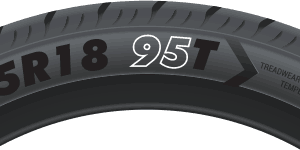 The load index can be conventionally called the tire load capacity coefficient - in other words, it is the limit load of a vehicle equipped with specific tires at the maximum intended speed. The tire load index is a numerical coefficient ranging from 0 to 209, where 0 corresponds to the maximum permitted load on the tire of 45 kg, and 279 - 136 tons. On the tire it is printed next to the speed index and is indicated by numbers - for example, 98T (where 98 is the load index, T is the speed index).
The load index can be conventionally called the tire load capacity coefficient - in other words, it is the limit load of a vehicle equipped with specific tires at the maximum intended speed. The tire load index is a numerical coefficient ranging from 0 to 209, where 0 corresponds to the maximum permitted load on the tire of 45 kg, and 279 - 136 tons. On the tire it is printed next to the speed index and is indicated by numbers - for example, 98T (where 98 is the load index, T is the speed index).
Let's consider a specific example - your tire is marked 98 T: the coefficient 98 shows that the load on one tire in this case should not exceed 750 kg. Accordingly, the load on all four wheels reaches 750 x 4 = 3000 kg - this is the total load capacity of the tires. Subtract from this number the weight of the car itself (for example, 1600 kg), the driver (90 kg) and passengers (85 + 75 kg) and get the potential weight of the cargo that you can load into your car - in this case, 1150 kg. This is the load that your car will withstand at a speed of 190 km/h.
Passenger car tire load indices range from 60 to 125 units (or from 250 to 1650 kg).
In the online store pit-stop.ee you can use additional filters to find tires only with the required load indexes.
| Load index | Tire load, kg | Load index | Tire load, kg | Load index | Tire load, kg |
|---|---|---|---|---|---|
| 60 | 250 | 82 | 475 | 104 | 900 |
| 61 | 257 | 83 | 487 | 105 | 925 |
| 62 | 265 | 84 | 500 | 106 | 950 |
| 63 | 272 | 85 | 515 | 107 | 975 |
| 64 | 280 | 86 | 530 | 108 | 1000 |
| 65 | 290 | 87 | 545 | 109 | 1030 |
| 66 | 300 | 88 | 560 | 110 | 1060 |
| 67 | 307 | 89 | 580 | 111 | 1090 |
| 68 | 315 | 90 | 600 | 112 | 1120 |
| 69 | 325 | 91 | 615 | 113 | 1150 |
| 70 | 335 | 92 | 630 | 114 | 1180 |
| 71 | 345 | 93 | 650 | 115 | 1215 |
| 72 | 355 | 94 | 670 | 116 | 1250 |
| 73 | 365 | 95 | 690 | 117 | 1285 |
| 74 | 375 | 96 | 710 | 118 | 1320 |
| 75 | 387 | 97 | 730 | 119 | 1360 |
| 76 | 400 | 98 | 750 | 120 | 1400 |
| 77 | 412 | 99 | 775 | 121 | 1450 |
| 78 | 426 | 100 | 800 | 122 | 1500 |
| 79 | 437 | 101 | 825 | 123 | 1550 |
| 80 | 450 | 102 | 850 | 124 | 1600 |
| 81 | 462 | 103 | 875 | 125 | 1650 |
Extra Load or XL
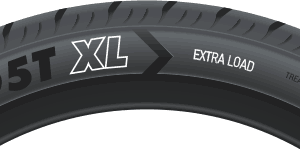 Each size for a passenger car, according to ETRTO (European) standards Tire and Rim Technical Organization (European Technical Organization for Wheels and Tires) may have two load indexes assigned to it - standard and increased. An increased load index in the tire marking is necessarily accompanied by an additional designation - XL, Extra Load or reinforced. This means that the actual load index value is 3 points higher than that indicated on the side. So, for example, size 205/55R16 may have a load index of 91, which allows one tire to carry a load of 615 kg, or 94, which equals 670 kg per tire.
Each size for a passenger car, according to ETRTO (European) standards Tire and Rim Technical Organization (European Technical Organization for Wheels and Tires) may have two load indexes assigned to it - standard and increased. An increased load index in the tire marking is necessarily accompanied by an additional designation - XL, Extra Load or reinforced. This means that the actual load index value is 3 points higher than that indicated on the side. So, for example, size 205/55R16 may have a load index of 91, which allows one tire to carry a load of 615 kg, or 94, which equals 670 kg per tire.
In the online store pit-stop.ee you can use additional filters to find tires with an increased Extra Load load index.
Double load index
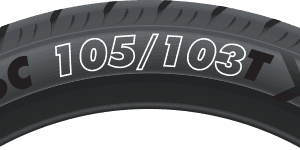 Dual load index means that for vehicles with four wheels with two axles, the load on the tire is calculated according to the first, largest index. And if the car has six wheels on two axles (dual tires for the rear axle), then to calculate the permissible load you need to take the second, smallest index.
Dual load index means that for vehicles with four wheels with two axles, the load on the tire is calculated according to the first, largest index. And if the car has six wheels on two axles (dual tires for the rear axle), then to calculate the permissible load you need to take the second, smallest index.
A similar use of sizes with a double rubber load index is found for tire sizes intended for use on minibuses or small trucks (weighing up to 6 tons). In this case, it is accompanied by the Latin letter “C” (commercial) and looks like this: 225/60 R16C 105/103T.
Example:
- For a standard car with tire size 265/65 R17С 120/117 you need to take the index 120 - this is 1400 kg per tire and the maximum weight that such a vehicle can carry would be 1400 x 4 = 5600 kg.
- For a vehicle with dual tires on the rear axle and tire size 265/65 R17С 120/117 you need to take the index 117 - this is 1285 kg per tire, maximum weight - 1285 x 6 = 7710.
This way, a car with dual tires on the rear axle will be able to carry more weight, even using the smaller tire size index.
In the pit-stop.ee online store you can use additional filters to find tires with only the required dual load indexes.
Speed index
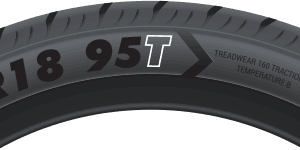 The speed index has a letter designation and indicates the maximum possible speed at which These tires can be used. For example, if the speed index is V, this means that driving on these tires over 240 km/h is not recommended. If the driver plans to drive at a higher speed, then tires need to be purchased with a higher index.
The speed index has a letter designation and indicates the maximum possible speed at which These tires can be used. For example, if the speed index is V, this means that driving on these tires over 240 km/h is not recommended. If the driver plans to drive at a higher speed, then tires need to be purchased with a higher index.
The pit-stop.ee online store has additional filters to find tires with the required speed ratings.
| Speed index | Speed, km/h | Speed index | Speed, km/h |
|---|---|---|---|
| L | 120 | U | 200 |
| M | 130 | H | 210 |
| N | 140 | V | 240 |
| P | 150 | W | 270 |
| Q | 160 | Y | 300 |
| R | 170 | VR | >210 |
| S | 180 | ZR | >240 |
| T | 190 | ZR (Y) | >300 |
M+S
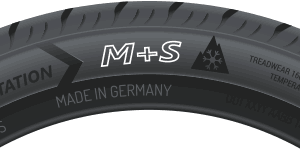 M+S is an abbreviation for Mud+Snow, which is literally translated from English like "mud + snow". With this marking, the manufacturer informs the consumer that the tire provides better traction on mud and snow than a regular summer tire. Each winter tire is marked M+S.
M+S is an abbreviation for Mud+Snow, which is literally translated from English like "mud + snow". With this marking, the manufacturer informs the consumer that the tire provides better traction on mud and snow than a regular summer tire. Each winter tire is marked M+S.
The letters M+S on the sidewall of the tires also indicate stronger grip on the road due to the use of softer rubber in the production; this factor minimizes such an unpleasant phenomenon as aquaplaning (full or partial separation of the wheel from the road surface). The level of rolling resistance also increases, providing more comfortable conditions during the trip. The specific rubber tread pattern marked M S allows them to move more confidently on snowy and wet roads, as well as cover significant distances off-road without any problems.
There is only one small nuance: the designation M S, unfortunately, is not a symbol protected by law (any manufacturer can put it on the tire, next to the standard size, speed and load indices). So, the promised improved driving performance in snow and mud, which is indicated by the m s marker, may turn out to be only a “publicity stunt”. However, famous brands (Nokian, Bridgestone, Yokohama and other manufacturers who value their reputation) are responsible for each symbol indicating certain qualities of the tire and applied to its surface.
A 100% guarantee that the purchased tires can really be classified as winter tires is provided by only the presence next to the M S symbol of an additional sign in the shape of a snowflake against a mountain background (more about it below). Only in this case does it mean that they have been tested in winter conditions.
(We also recommend that you familiarize yourself with the special section of our website dedicated to winter tires)
Alpine or Three Peak Mountain Snowflake (3PMSF)
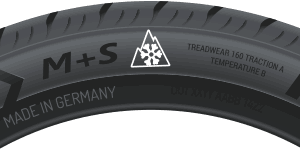 Recognizing the need for more relevant and useful measurement of true winter performance, As well as a way to differentiate all-season tires from winter tires, the Rubber Manufacturers Association (RMA) created the 3PMSF (Three Peak Mountain Snowflake) symbol for winter tires. When you see this symbol on the sidewall of a tire, you can be sure that it meets the more stringent winter traction requirements and has been rated in "heavy snow" conditions.
Recognizing the need for more relevant and useful measurement of true winter performance, As well as a way to differentiate all-season tires from winter tires, the Rubber Manufacturers Association (RMA) created the 3PMSF (Three Peak Mountain Snowflake) symbol for winter tires. When you see this symbol on the sidewall of a tire, you can be sure that it meets the more stringent winter traction requirements and has been rated in "heavy snow" conditions.
Maximum safety on winter roads is ensured only by winter tires that have this marking - a three-peak mountain with a snowflake. To obtain it, the tire must exceed an acceptable threshold of the “snow grip index” and guarantee the minimum required performance in winter conditions (which are regulated by the relevant regulations on “vehicle safety”).
Such tests are carried out by tire manufacturers themselves or third-party companies, based on the results of which a tire can be recognized as a winter tire, undergo certification and be allowed for sale.
The 3PMSF marking (symbol of a snowflake with three mountain peaks in the background) on tires is the official marking of winter tires. It is this badge that confirms that the characteristics of the tire comply with the regulations of winter tests and it has sufficient grip properties for driving on snow and at low temperatures.
This mark is the only element confirming the actual properties of winter tires. Tire models bearing this mark are adapted to appropriate winter weather conditions and do not lose their parameters at subzero temperatures. The 3PMSF mark is standardized and controlled by the European Union authorities. It guarantees that tire manufacturers have met strict testing conditions and that the tires are suitable for use in harsh winter weather conditions.
According to the legislation of the Republic of Estonia, from December 1, 2022, winter tires without studs must meet internationally agreed requirements and have appropriate markings in the form of a mountain with three peaks and a snowflake.
(We also recommend that you familiarize yourself with the special section of our website dedicated to winter tires)
Run-Flat
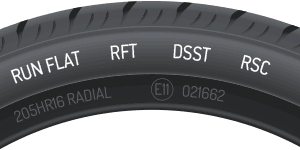 Tires marked Run-Flat allow continue driving the car at a speed no more than 80 km/hwhen the tire pressure COMPLETELY drops (in the event of a puncture or cut). On these tires, depending on the manufacturer's recommendations, you can drive from 50 to 150 km. Different tire manufacturers use different designations for run-flat technology:
Tires marked Run-Flat allow continue driving the car at a speed no more than 80 km/hwhen the tire pressure COMPLETELY drops (in the event of a puncture or cut). On these tires, depending on the manufacturer's recommendations, you can drive from 50 to 150 km. Different tire manufacturers use different designations for run-flat technology:
RUNFLAT, RUN FLAT, RUNonFLAT, RFT (short for Run Flat Tire), RSC (short for Run-flat System Component), DSST (Dunlop Self-Supporting Technology), Goodyear EMT (Extended Mobility Technology), Kumho XRP, Michelin ZP (Zero Pressure), Yokohama ZPS (Zero Pressure System), Continental SSR and so on.
The online store pit-stop.ee has a special filter to find run-flat tires.
Seal Inside
 Seal Inside™ technology allows the vehicle to continue moving without losing pressure air even after a tire puncture by an external object, covering almost 85% of possible accidental causes of loss of pressure. No special wheels or TPMS (Tire Pressure Monitoring System) are required to safely use Seal Inside™ technology on your vehicle. It can be used on any car.
Seal Inside™ technology allows the vehicle to continue moving without losing pressure air even after a tire puncture by an external object, covering almost 85% of possible accidental causes of loss of pressure. No special wheels or TPMS (Tire Pressure Monitoring System) are required to safely use Seal Inside™ technology on your vehicle. It can be used on any car.
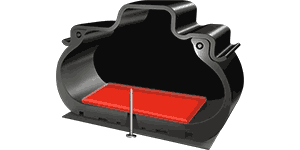 When a tire is punctured, the sealant sticks to the object that caused the puncture , creating a seal around the object if it remains in the tire. When an object is removed from the tire, the sealant is "pulled" with the object into the hole, sealing the edges of the hole.
When a tire is punctured, the sealant sticks to the object that caused the puncture , creating a seal around the object if it remains in the tire. When an object is removed from the tire, the sealant is "pulled" with the object into the hole, sealing the edges of the hole.
In the pit-stop.ee online store you can use an additional filter to find tires with Seal Inside technology.
Tires for electric vehicles
Electric cars have several important differences from conventional cars with internal combustion engines, which affect the selection of tires and force manufacturers to develop new models that sometimes have to combine incompatible characteristics, which in turn increases the cost of the final product.
Here are some of the aspects to consider:
- The weight of the vehicle is increased due to the presence of a battery. Therefore, tires for an electric vehicle must have an increased load index
- An electric car accelerates from a standstill much faster. With higher torque engines, acceleration is faster and tire wear is higher. To prevent excessive wear from being fatal in the future, EV tires must have a stiffer design and a material that provides good traction.
- The electric car engine operates almost silently. Quiet tires are preferred for these vehicles. So-called quiet tires are specially designed tire models that use a special polyurethane layer inside the tire.
- The less the tires resist rolling, the more economical the battery charge will be.
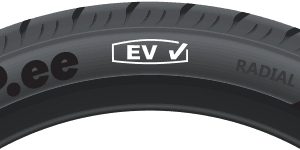 Tire manufacturer Continental has recently introduced special markings for tires - the EV compatibility symbol confirms that the tire meets the special requirements of electric vehicles. Other manufacturers are in no hurry to join this initiative, despite the fact that they develop and produce tires specifically for electric vehicles (for example, Michelin Pilot Sport EV, e-Primacy; Hankook iON evo; Pirelli PZero AS Plus Elect; Nokian Hakkapeliitta R5 EV, Hakkapeliitta 10p; Goodyear ElectricDrive GT, Bridgestone Ecopia EP500, Turanza EV, Blizzak LM-500; Continental Conti.eContact and others)
Tire manufacturer Continental has recently introduced special markings for tires - the EV compatibility symbol confirms that the tire meets the special requirements of electric vehicles. Other manufacturers are in no hurry to join this initiative, despite the fact that they develop and produce tires specifically for electric vehicles (for example, Michelin Pilot Sport EV, e-Primacy; Hankook iON evo; Pirelli PZero AS Plus Elect; Nokian Hakkapeliitta R5 EV, Hakkapeliitta 10p; Goodyear ElectricDrive GT, Bridgestone Ecopia EP500, Turanza EV, Blizzak LM-500; Continental Conti.eContact and others)
Also a convenient reference point can be the Original Equipment or OE marking on the tire (read about this below).
The online store pit-stop.ee has a separate filter for displaying tires adapted for or specially created for electric vehicles.
Original Equipment or OE marking
An optional designation indicating that this particular tire model is included in the “factory” set of cars of certain brands.
| Car manufacturer | OE marking | Add. information |
|---|---|---|
| Alfa Romeo | AR | |
| Aston Martin | AM, AML | |
| Audi | AO, AO1, AOE RO1, RO3, RO3 |
Audi Original Audi Original Extended (ROF) Audi Quattro |
| Bentley | B | |
| Bugatti | BG | |
| BMW / Mini | ★ ★MO ★MOE |
BMW / Mini (“Star” marking) BMW & Mercedes-Benz BMW & Mercedes-Benz Run Flat |
| Cadillac | TPC | |
| Chevrolet | TPC | |
| Chrysler | C1 | |
| Ferrari | K1, K2, K3, F01, F, F03, F02 | |
| Ford | FO2, FO1, FO | |
| Ford Performance | FP | |
| Genesis | GOE | |
| GM | TPC | |
| Hyundai | HN | |
| Jaguar | J | |
| Lamborghini | L | |
| Land Rover | LR | |
| Jaguar & Land Rover | JLR | Jaguar Land Rover |
| Lancia | LZ | |
| Lotus | LS, LTS | Lotus Exige S |
| Lucid | LM, LM1 | |
| Maserati | MGT | Maserati Genuine Tires |
| Maserati & Jaguar | MGT J | Maserati Genuine Tyres & Jaguar |
| McLaren | MC, MC1 | Mclaren |
| Mercedes | MOE MO MO1 MO-S MO-V |
Mercedes Original Extended (Run Flat) Mercedes Original Mercedes Original (for AMG models) Mercedes Original Silent Mercedes Original Viano |
| Nissan | NR1 | Nissan GT-R Nismo |
| Opel | OP, OP1 | |
| Peugeot Citroën: | SI | |
| Polestar | POL | |
| Pontiac | TPC | |
| Porsche | N0, N1, N2, N3, N4, N5, N6, NA0, ND0, NF0 | |
| Renault | RE | |
| Tesla | T0, T1, T2,… | |
| Toyota | A | |
| Volkswagen | ⊕ VO |
|
| Volvo | VOL |
Data from the European Energy Labeling Product Register
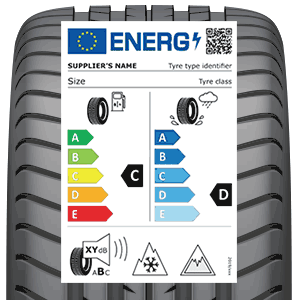 In addition to various information stamped on the side, each tire sold in The EC is equipped with a special label containing basic information about the tire.
In addition to various information stamped on the side, each tire sold in The EC is equipped with a special label containing basic information about the tire.
This marking replaced the EU Tire Label (European tire marking) in 2021. The labeling system has been redesigned, the key data remains unchanged, but several more important designations have been added. In addition to the fact that the label continues to provide standard data on fuel consumption, wet grip and noise levels, the following have been added:
- article,
- QR code
- information about the manufacturer, tire model and size,
- grip parameters on snowy and icy roads.
Tires are rated based on three criteria: fuel efficiency, wet grip and external rolling noise.
Fuel efficiency (rolling resistance)
The first criterion that can be seen on the tire label. Approximately 20% of a car's fuel consumption depends on the tire. The higher the rolling resistance of a tire, the higher the vehicle's fuel consumption. The label indicates the tire's rolling resistance class and is ranked from A to G. Thus, a tire with an A rating (label in the upper left corner) has the lowest rolling resistance, while a G rating indicates the highest level of this criterion. Therefore, tires rated A allow the vehicle to consume less fuel than tires rated G.
Grip on wet surfaces
The criterion characterizes the length of the braking distance on a wet surface. Tires are rated from A to F. For example, the difference in braking distance between a tire rated A and a tire rated F is 18 meters, assuming the car is moving at a speed of 80 km/h. To illustrate, 18 meters is approximately four car lengths, such a distance can help avoid a collision or even save a life.
External noise
The criterion indicates the noise level that occurs when the tire moves, measured in decibels. Tires with rolling noise up to 60 dB are rated as the quietest, and tires with rolling noise exceeding 74 dB are very noisy. Recall that a decibel is a tenth of a bel, which is based on the decimal logarithm. That is, if the sound volume increases by 10 dB, this means that the sound intensity has increased 10 times.
In the online store pit-stop.ee, in most cases you can see the corresponding marking on the product page. This data comes from the European Register https://eprel.ec.europa.eu/screen/product/tyres
